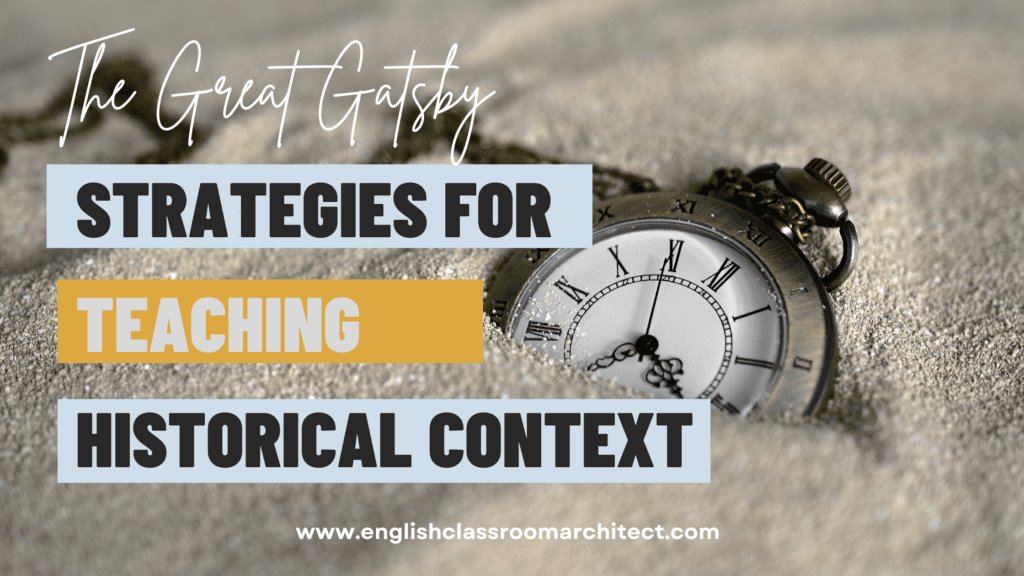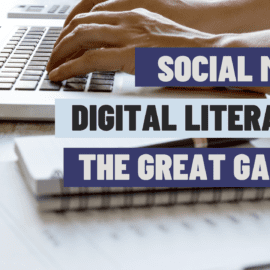You’re getting ready to teach The Great Gatsby, and you are looking for an engaging way to teach the historical context of the novel. You think about Prohibition and The Great Gatsby and perhaps two of the images that come to mind are jazz clubs and speakeasies. Excellent, now how to bring that to life for students? If you were to do a search for activities for teaching The Great Gatsby you will likely find an activity for staging a “Gatsby-esque” party. This advice is widespread and well-intentioned, but also somewhat misguided. Understanding the historical and literary context for The Great Gatsby will help students to understand the text, but how do you best structure this learning experience?

Table of Contents
Understanding the The Great Gatsby Historical Context
Popular culture often focuses on the hedonism of Jay Gatsby’s parties. While we, as expert readers, understand that to say this is what the text is about would be playing to a major misconception because Fitzgerald is criticizing this carefree culture; for our teenage readers the glamorous parties are often a key takeaway.
In Understanding by Design, authors Grant Wiggins and Jay McTigue outline the problem: “The error of activity-oriented design might be called “hands-on without being minds-on”—engaging experiences that lead only accidentally, if at all, to insight or achievement. The activities, though fun and interesting, do not lead anywhere intellectually.” Starting (or ending) with a so-called “Gatsby party” can set students up for misinterpreting the novel. While this may be an activity that students enjoy, it gets them no closer to understanding the novel or The Great Gatsby historical context, and it may in fact hamper their understanding.
What Is the The Great Gatsby Historical Context?
But, understanding aspects of The Great Gatsby historical context can lead to deep engagement with the novel. The questions we want students to grapple with and to ponder related to the culture of the time as they are reading is a good place to start. What is the significance of Jay Gatsby’s connection to Meyer Wolfsheim? Why are there few references to people of color in the novel? Why did Fitzgerald include multiple references to eugenics? How important to Tom’s characterization is Nick’s initial description of him being a football player?
As you may notice, even this brief list of questions opens up opportunities for delving into the historical context of The Great Gatsby. Looking into the Meyer Wolfsheim connection will lead students to a more nuanced understanding of Jay Gatsby. Since bootlegging in New York City connected him to organized crime, the danger inherent in this connection becomes clearer. As our unreliable narrator, Nick mentions clues to this fact, but because Nick does not seem to understand or admit to what’s going on, we as the readers may gloss over this as well. We are quick to understand Tom’s racist comments, but the additional references to eugenics authors in Jay Gatsby’s home library may give us pause if we know to look for it. Knowing that college football became very popular in the 1920s and that professional football began in this decade gives additional information as to how we might interpret Nick’s introduction of Tom.
What Historical Context of The Great Gatsby to Teach?
Now, you may be thinking, if I teach all that Great Gatsby background information, when do I actually teach the novel? And yes, you are right. As a result, effectively teaching the context requires a clear understanding of what you will be focusing on during the unit so it can be streamlined.
This streamlining has so many benefits. With multiple options for how you could design your unit, it can easily become a hodgepodge of ideas. By limiting to a few enduring understandings, you can focus your supplements, assignments, and discussions.
Streamlining will help students know what to expect and look for as they read. For you, it will protect your energy by reducing your cognitive load and leaving space for productivity, student engagement, and your never ending grading list.
Strategies for Teaching The Great Gatsby Historical Context
Strategy 1: Not Teaching The Great Gatsby Historical Context
At this point, it is a good idea to recognize that you are not alone here. For many students, their American Literature Chief course is taken at the same time as an American History Course. Do Economics or Sociology teachers in your school teach historical issues of wealth and class? Discuss with your cross curricular colleagues to determine what is covered and when to determine if and how you can build on their curricular expertise. I can understand the desire to provide all the necessary context yourself so that you can drive the timeline and ensure the quality of content (believe me, I’ve been there), but this is an area where we can reasonably share responsibility and take a little off our plates.
Could you partner with your librarian to co-teach some lessons? Your school librarian may jump at the opportunity to help students explore primary sources and build strong research skills. Looking to your librarian as a resource could be beneficial for students to build a relationship with the library and the librarians, but partnering in this way can also help to make your workload more manageable.
If you decide that you need to teach the context, there are fun ways students can use inquiry for context-building. Students could be provided with access to newspapers or advertisements and be tasked with searching for information related to specific cultural trends, like the gender norms of the period, for instance. Ideally, you will connect back to specific details, articles, and advertisements as your unit continues.
Strategy 2: Incorporating Multimedia Sources
Since media like films, podcasts, and videos can also be analyzed for structure and content delivery, they can do double duty in providing context and also an opportunity for sharing literary skills. There is so much to be gained when film is incorporated. Whether we like it or not, film captures students’ attention, and we can use that to our advantage by introducing, highlighting, and deepening content and conceptual understanding. There are so many great films and podcasts to connect to The Great Gatsby, I will devote a future post to the best multimedia to pair with the text.
When using multimedia it is important to help students make clear connections to themes and contents. As you plan, consider ways you can loop back to the content. Recognize that students may not retain the information important to the novel study, so be mindful of ways you can emphasize important ideas and consider ways you can explicitly loop back to the content during your novel study.
Strategy 3: Assigning Historical Research Projects
Having students investigate a particular aspect can be an interesting way to help students understand The Great Gatsby cultural context. Additionally, this strategy allows you to teach research skills while building central understanding.
The Great Gatsby Location and Time
An assignment I use to help students with The Great Gatsby historical context is to assign them a New York City Prohibition-Era gangster to research. By having them look closely at organized crime of the 1920s, they have a clear understanding of the link between bootlegging and violent crime. Using this approach, compared to previous years when I did not use this assignment as context-building, students quickly picked up on the details related to Jay Gatsby’s life of crime. At the end of the novel, they bring up the increasingly sketchy relationship with Meyer Wolfsheim and wonder at why his protege would be Jay Gatsby’s butler. Their understanding of the seedy underbelly of the city greatly enhances their reading of the text.
Strategy 4: Teaching a Harlem Renaissance Unit
An excellent strategy is to really dig into the understanding of the Harlem Renaissance. This approach addresses many curricular objectives. For one, a Harlem Renaissance unit clarifies The Great Gatsby cultural context. To me, the historical context of the jazz age fits squarely in a Harlem Renaissance unit, more so than in a “Great Gatsby Unit.” However, the knowledge built around an understanding of the Harlem Renaissance could be well applied to a reading of The Great Gatsby.
Students can spend time with poetry, an often neglected area of ELA curriculum, and also build background on the jazz age and important historical figures of the time.
My suggestion is to plan for a stand alone unit so you can give this period the attention it deserves. I’ve found that personally and anecdotally when included as context for The Great Gatsby, teachers tend to rush through or cover the content superficially.
Conclusion
Teaching historical context increases student understanding and engagement. It is well known that a major factor in student comprehension is the degree to which they can bring a contextual understanding to a text. However, too much information can have the opposite effect on students, leading to overwhelm and low retention.
As we work on building curriculum, it is important that we are mindful of our capacity and we seek opportunities to lean on outside expertise. This may come in the form of a colleague, a podcast, or even a film. Approaching planning in this way allows for us to appropriately address all of the demands put on us as high school English teachers.
Products in My Store You May Be Interested In
- American Dream Celebrity Brackets – this free resource pairs carefully curated celebrities and wealthy individuals head to head to determine who best embodies the American Dream. This is a fun resource with a variety of writing and discussion options.
- The Great Gatsby Prohibition-Era Research Project
– help students to understand the significance and importance of Jay Gatsby’s connection with bootlegging. This project can change student’s perspective and help better analyze relationships as they read!
- American Dream Research Project for Teaching the Research Process – using a narrative process for synthesizing research, students will evaluate Hollywood’s portrayal of the American Dream.



